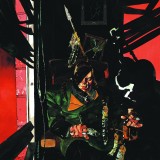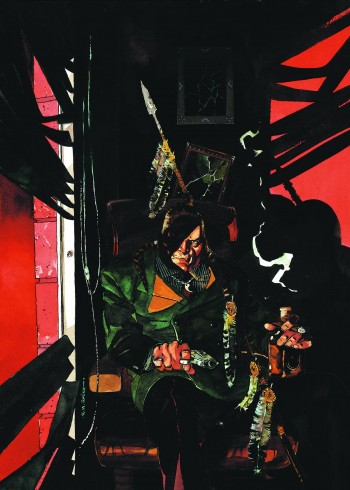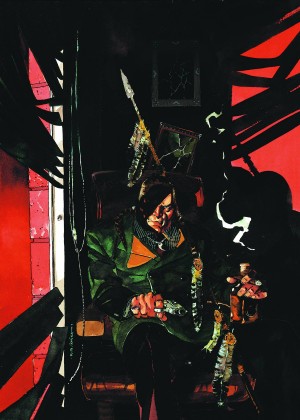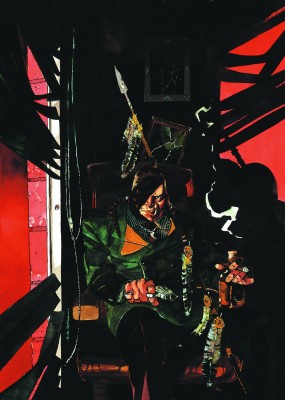
GRAPHIC NOVEL REVIEW: Scalped Deluxe Edition Book Two
ALL IN THE WOMAN’S LOVE If there is something admirable with DC/Vertigo Comics nowadays, it is vision to publish deluxe edition of some of the highly critically, influential and awarded titles. Right now, it unleashes SCALPED THE DELUXE EDITION BOOK TWO, written by one of Marvel’s top comic writers, Jason Aaron, and drawn by some […]
ALL IN THE WOMAN’S LOVE
If there is something admirable with DC/Vertigo Comics nowadays, it is vision to publish deluxe edition of some of the highly critically, influential and awarded titles. Right now, it unleashes SCALPED THE DELUXE EDITION BOOK TWO, written by one of Marvel’s top comic writers, Jason Aaron, and drawn by some of the most talented illustrators in the comics industry right now, R.M. Guera, Davide Furno, and John Paul Leon (with Giulia Brusco as colorist).
This book contains Scalped #12-#24 (three chapters), clocking 320 pages, and special features, like Ed Brubaker’s introduction that includes the definition of “noir”, Jason Aaron’s introduction that served as his pitch to this independent series, and lots of art works, particularly the “Scalped Sketchbook” by R.M. Guera that features excluded illustrations that were ultimately left out in the final book. Moreover, the paper used here is highly sturdy than many Marvel hardcover deluxe editions, which is a huge plus factor for the competition itself. In addition, the cover art by Guera are aesthetically encapsulated the entire theme of this very gritty and noir suspense-filled drama series.
For new readers out there, Scalped is the story of the lives of the Native Americans in the Prairie Rose Indian Reservation, particularly the main characters FBI undercover agent Dash Bad Horse and the community’s head chief, Lincoln Red Crow. And, Scalped is Jason Aaron’s first ever comic series before being discovered by mainstream comics.
As said, this book has three independent but interlocking chapters that can be read separately but at the same time, makes readers to go back and reread the whole thing. As master noir writer Ed Brubaker specifies in his introduction, Scalped focuses more in characterization and explorations rather than on plot-narrative schema. That is what makes a great noir and suspense series should be, and serious comic readers of gritty and noir comics should place Scalped as one of the recommended comic book reading list.
The first arc deals with two murders, most especially with Bad Horse’s mother and tribal community leader, Gina. Jason Aaron knows his Sigmund Freud apparently and explores the character’s deep torn feelings with his mother, his allegiance, his sense of belongingness, his heritage, and his supposed legacy. Simply put, this is a good elementary Oedipus complex (or loosely translated as “mommy issues”) case study in the graphic illustrative format in a rather twisted form. The second part focuses on Bad Horse’s search for the murderers that ends up tragically and brings him to deeper depression than ever. And the last chapter concentrates on the illegal drug activities of a certain local Native American drug dealer who ultimately faces his worst nightmare.
However, Jason Aaron loves characters more than the plots themselves and he makes sure that his players shine one way or another, for better or otherwise. For examples, Gina may be dead but multiple flashbacks with her son and her early years of activism present the complexities she possesses, both as a mother/woman and as a strong-willed Native American heritage protector. Native American histories are extricated and referenced here to match the urgency of retaining the sense of historical pride in the midst of social decadence and structural collapse in the clash of modernity and traditionalism. Another one is Red Chief’s wayward daughter, whom Bad Horse confides whenever he is all burnt out and nearly spiraled out of control. Again, her motivations are exteriorly opaque and being rebellious, but upon glimpsing her past, all she wants is a very “normal” life, but as the cliché goes by, she was born in the wrong place in the wrong time. Another one is another tribal police officer tasked by the Chief to find the murderer whose exterior seems to be contradicting to his inner thoughts and his rather tragic past. In respect of Native American culture and heritage, Jason Aaron (and the artists) illustrates various practices and put these into context (with some artistic liberties understandably) on how these work and being relevant to their society. The eldest child of the murdered victim whose thirst of vengeance and eventually demise drive the main character to almost abysmal suicidal and depressive tendencies, despite the latter’s better intention for the family’s better future. And, the villains are fleshed out as complex as well as riveting. The Chief’s enforcer is obviously the implementer of his boss’s will, but more often than not, goes beyond the call of duty and do something nasty just to strengthen his master’s grip. The sadistic one-armed Mister Brass is one sure monster, torturing and killing community members whom he perceives as “monsters” despite the eloquence he utters and delivers to the leader and people he encounters. Finally, the boorish and hypocritical attitude FBI handler possesses can make the readers root for his karmic retributions sooner than later.
What makes this volume engagingly read is the fact that both Bad Horse and the Chief want to do better despite the enormity they respectively possess. The former just realizes he loves his mother and the heritage he once despised with gusto; while the latter is another case study of the rise of the Machiavellian archetype whose past is the trajectory point and never ever look back until his last breath (perhaps). The transformation from an idealist activist to the shrewd and dominating warlord but still respect Native American culture and identity is soon to be Jason Aaron’s narrative trademarks in his future evolutionary comic storytelling development (i.e. read his Southern Bastards: The Gridiron, and Men of Wrath to illustrate Aaron’s fondness of historical trajectory as the instrument of individual change). Furthermore, we can relate with this one for there are internal conflicts between the “traditionalists” and the “progressives” that often find themselves at loggerheads with one another on how to maintain their cultural practices and move forward with the rest of the modern societies without being either compromised or obliterated their identities. It is a fact that Native Americans are the most marginalized of all societies in the so-called Land of Free, and Jason Aaron highlights the obvious, the bitter truths (which is basically ironic for they are true inhabitants and owners but tragically ends up being pushed around by the succeeding settlers, most particularly white people who contribute mostly to the nasty racially disturbing stereotypes that still persist presently). These two personalities are connected with the woman they share the most, Gina. No wonder why after reading this well-crafted and character-driven graphic novel, readers are gearing for the third part that promises more twists-and-turns. Moreover, side notes on police brutalities, graft and corruption, the omnipresent Catch-22 dilemma, white washes, red tapes, subterfuges, and other stuffs that simply decaying the Reservation are so relevant to our societies nowadays, as if humanity is yet to learn something or even transcend from these painful and deceiving traits.
We can further witness how Aaron utilizes some of the non-linear storytelling tropes in narrating the trivial of the characters involved. This is particularly evident in the third arc where the Chief makes the first entrance in the future then later on, goes on telling what transpired then in the present times up to the last page of the overall story. More so with his multiple flashbacks that illuminate how and why Gina is the most integral, but silently, piece of the puzzle in the entire story. This is proof that one’s contributions to the society echoes strongly to those it left behind. And the writer is aware of this emotional spectrum and utilizes this by interjecting these historical moments to the main characters.
All artists involve here are minimalists at best. Even the cover artists (particularly Jock) draw some of the best gritty portrayals of Native American and characterized outlooks yet. R.M. Guera is the main illustrator here and he intricately draws the faces of despair, depression, destructiveness and decadence of the inhabitants and the main characters in this book alone. Even the mature and other graphically gory scene is maturely done and in contextual mode since hopelessness is so predominately present and that ambiance alone dictates the direction of the rest of the series. More gravitating in Guera’s minimalist and detailed scratchy artworks are his nightmare illustrations and other historical flashbacks some of the main characters experienced that feel so realistic as they are integral to the characters’ development and the possible psychological profiling which motivates these damaged players in the first place. Davide Furno and John Paul Leon may have respective artistic interpretations than Guera, but they nevertheless remain consistent on Guera’s artistic visions on the grittiness, emotionally depressing, and the pinch of illumination these characters may or otherwise have in store. Personally, Giulia Brusco should be commented here for the colors here are the ones that dictate the tempo and cadence of the series. True, the dark colors simply dominate more than ninety percent (90%) that demonstrates the power of noir and the cynicisms the direction necessary to march on from the first page up to the last panels. The only primary color is red, and Brusco uses it effectively in connoting direct violence and bloodshed whenever the narrative shifts to the worse. This is so evident whenever Bad Horse is in trouble or exploded; and when Mister Brass conducts his unholy torture techniques on hapless victims just to satisfy his brand of sadism.
Jason Aaron’s gritty narrative; R.M. Guera, Davide Furno and John Paul Leon’s art interiors; the cover arts led by Jock; and other great additional features actually carry the positivity of this brilliant edition. But, as usual, DC/Vertigo deluxe editions often, if not always, suffer the same old weaknesses that seem to drag their almost excellent hardcover treatments. First and foremost, the binding is still glued than being sewn, and the reading experience is basically tedious that even after 30 to 40 pages, these same pages flip back unless I hold them tightly. Is sewn binding copyrighted, DC/Vertigo? I hope DC/Vertigo Comics hear me out and make significant changes on this regard unless it has other matters to take care with.
Overall, Scalped The Deluxe Edition Book Two can be read independently alone, though it is also wise enough to gear on the introductory chapter and other succeeding parts in order to fully comprehend why Jason Aaron loves writing Southern tales and anything gritty and noir. His Southern Bastards, Wolverine tales, Men of Wrath, Ghost Rider and Thor runs are later developments of his ever evolving writing skills. One serious Jason Aaron reader (and noir followers as well) should pick up Scalped, his inaugural or baptism of fire comic book series. Gladly, DC/Vertigo Comics promises to complete the entire Scalped deluxe editions project and Book Two alone is the best treatment so far, though some asterisks are highlighted nevertheless. SCALPED is a MUST READ!


















